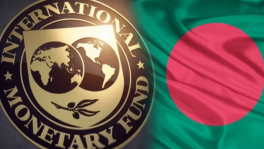Will growth momentum run out of steam?
Poor performance in the revenue front appears to be the main economic woe forcing the government to rely heavily on banks to meet both operating and development expenditures

The current fiscal year ended its first half with most of the broader economic indicators, except inward remittance, deteriorating compared to their year-ago period.
The budget deficit spiralled beyond five percent of the GDP – recommended safe limit for growing economies like Bangladesh – in the last fiscal for the first time in recent history. Keeping it within the budgetary limit may be difficult this time too, if the revenue sector continues to perform poorly in the remaining half of the fiscal year.
Poor performance in the revenue front appears to be the main economic woe forcing the government to rely heavily on banks to meet both operating and development expenditures.
Despite a 7.3 percent year-on-year growth in the first half, collections of the National Board of Revenue were far behind budgetary target due to slower growth in customs and VAT. Only income tax revenues saw substantial growth as the revenue agency receives individual taxes without much effort.
Export shows a more worrying performance, posting a 5.84 percent negative growth in July-December compared to 14 percent growth in the past year's same period.
Imports were also in the negative zone. The good sign is that food import bills, mainly rice import, dropped remarkably while capital machinery and raw material imports rose.
Inward remittance stands out as the lone hope in the external sector with more than 25 percent growth until December over the last year. It came mainly on the back of two percent cash incentive announced by the government for money remitted through legal channels, the central bank explains.
Service account remains a grey area like before, as the Bangladesh Bank does not put the figures of outgoing remittance taken home by foreign workers and employees as well as Bangladeshis spending hugely abroad for education and treatment – the amount could be in billions of dollars.
Current account deficit was lower in the July-November period than the previous year, mainly because of increased inflow of workers' remittance.
Though not significant, foreign direct investment rose slightly.
Headline inflation in December crossed the budgetary range of 5.5 percent.
Banks in a tight corner
Already burdened with a huge build-up of bad loans, to the tune of nearly Tk97,000 crore as of November, the banks are in a tight corner as they are under pressure to return to dictated interest rate regime, which may erode their profit and deposits.
Data from the Bangladesh Bank show that deposit growth saw a sharp fall.
The government exhausted its whole fiscal year's target of bank loans in six months, taking Tk48,015 crore from banks until December – up from the year-ago period by Tk3,395 crore. The central bank enhanced its monetary target for public sector credit growth to create room for the government to borrow more for banks.
A further increase in government borrowing will limit banks' capacity to lend to the private sector, whose credit increased by 2.53 percent in November, slower than last year. Single digit interest rate will hurt credit inflow to the private sector further as banks will be reluctant to lend at low cost, a central bank report said.
But public-sector credit surged 32 percent this year, seven times higher than the previous year, the Bangladesh Bank figures show.
Projections and ground realities
Steady growth over the years put Bangladesh's economy under the global spotlight, prompting many financial and rating agencies to project further growth escalation.
But that prospect may turn grim if broader economic indicators continue to deteriorate and internal wounds of the economy are not healed by prudent fiscal and monetary management immediately, economists warn.
Benign negligence of ground reality and sense of complacence may prove futile, they caution, calling for fundamental reforms in revenue, public expenditure and banking fronts.
Stymied growth in India, after years of high growth, has also come as a reference for the "middle-income trap".
Bangladesh's economy is growing at eight percent and is projected to rank 24th in 15 years from the present 40th. The country has already transitioned from low-income to lower-middle-income and met UN thresholds to graduate from the Least Developed Country status in 2024.
The government set its own targets of reaching the middle-income stage by 2021 and developed economy by 2041.
Transition to the next level of development requires a sustained higher growth. Bangladesh expects 8.2 percent growth in the current fiscal and even higher growth in coming years.
"Our commitment is to achieve a growth rate of 10 percent by 2023-24, and maintain that rate until 2041 so that we can lay down a solid foundation for becoming a high-income country by that time," Finance Minister AHM Mustafa Kamal said in his budget speech in June last year.
Former finance minister AMA Muhith has allayed the fear of slowdown. In an interview with The Business Standard, he said, "I think despite the constraint of international development, particularly China and India's development, at least three years of good growth is assured for Bangladesh. It must happen."
"We wanted 10 percent, but we will not be able to achieve 10 percent. But eight percent plus is a very good growth rate. None except China and India reached 10 percent," Muhith said.
But independent economists and analysts are not that much sure that the economy will be able to keep its growth momentum up unless macroeconomic fundamentals improve.
"Most of the indicators, which were good one or two years ago, are not at a satisfactory level now, rather deteriorated somewhat. Only exception is remittance," said Dr Salehuddin Ahmed, former governor of the Bangladesh Bank.
In this context, it will be difficult to maintain the growth performance, he said.
Problems like surging default loans in the banking sector, huge government borrowing, revenue shortfall and budget deficit need to be addressed.
It will be difficult to achieve faster growth unless fiscal and monetary management improves, suggested Dr Salehuddin, who now teaches at Brac University's School of Business.
Budget deficit is rising due to lack of proper fiscal management. The government is borrowing heavily from banks and ultimately the private sector will suffer. Imposing tax on proceeds of savings certificates was not a prudent policy as it will hurt small savers and discourage savings, the former central bank governor pointed out.
Executive Director of Policy Research Institute, a local think tank, Dr Ahsan H Mansur said the growth momentum that was created in post-2010 is running out of steam.
"It is largely because of lack of reform, unaddressed problems accumulated over the years and a kind of complacency at the policymaking level that everything is fine," he said.
The "business as usual" policy framework will not take us to upper middle income country or high-income country, he pointed out.
The fundamental issues like investment, private investment in particular, including FDI – which being stagnant at 22-23 percent level together – are completely inconsistent with the growth scenario estimated or projected by the government, said the economist, who had a long career at the International Monetary Fund in fiscal affairs and policy review.
"Unless we can sustain the high growth that has been attained recently, it would not be possible to attain the goals of moving to the middle-income status and high-income status eventually by 2041," said Dr Rizwanul Islam, former special adviser at the International Labour Office, Geneva.
The economist cited that Indonesia, Thailand and the Philippines were not able to maintain the high growth that they attained in earlier decades and they could not make it to the status of developed countries. "The most recent example is of course India, which attained high growth but in 2019, their growth declined very sharply."
Even China, which attained double-digit growth rate for more than two decades, has not been able to sustain that kind of growth; their growth rate has declined very substantially, Dr Rizwanul pointed out.
"So, that is why one has to worry about the danger of the 'middle-income trap' and strive for sustaining the high growth," he concluded.


 Keep updated, follow The Business Standard's Google news channel
Keep updated, follow The Business Standard's Google news channel













